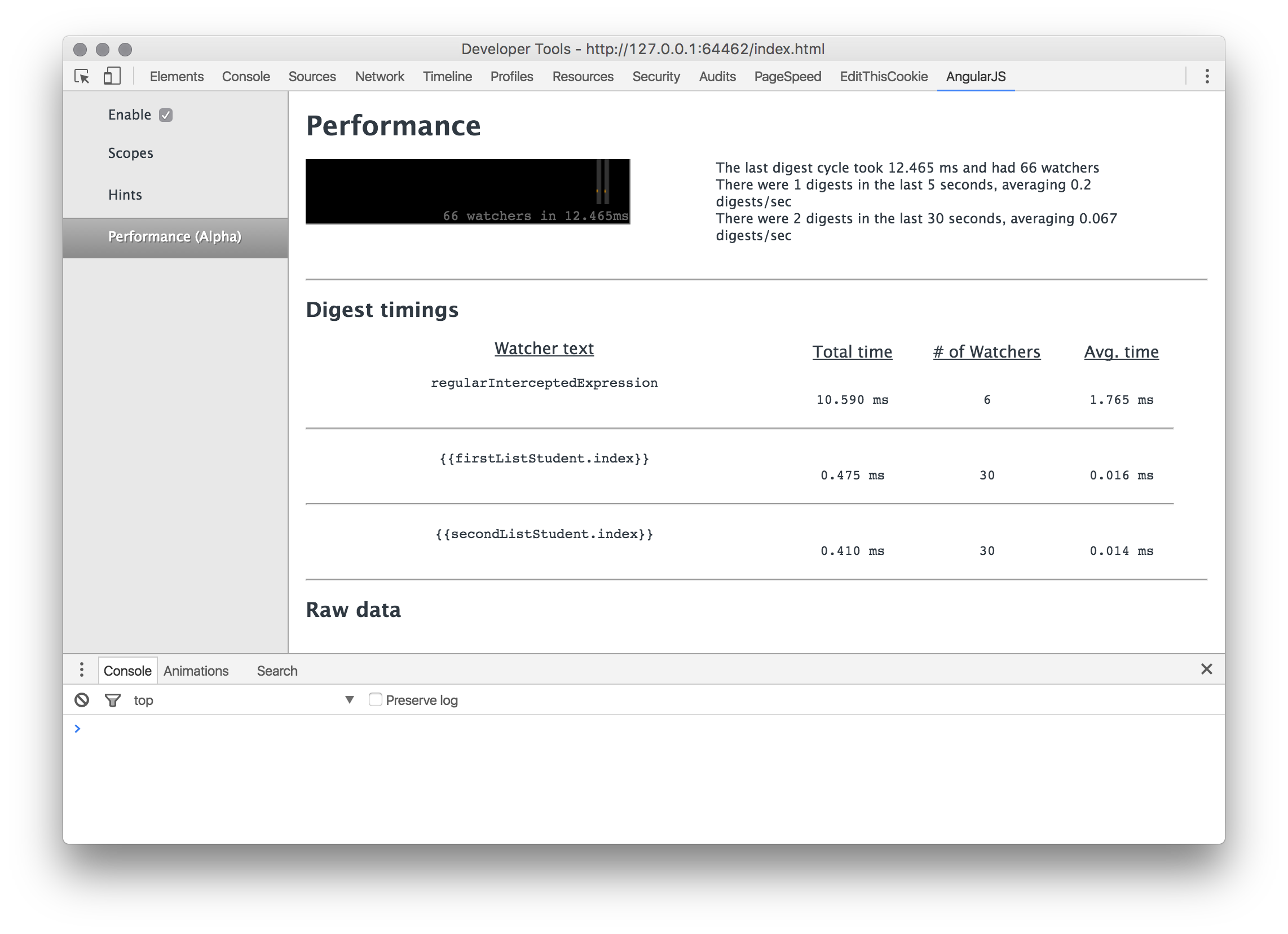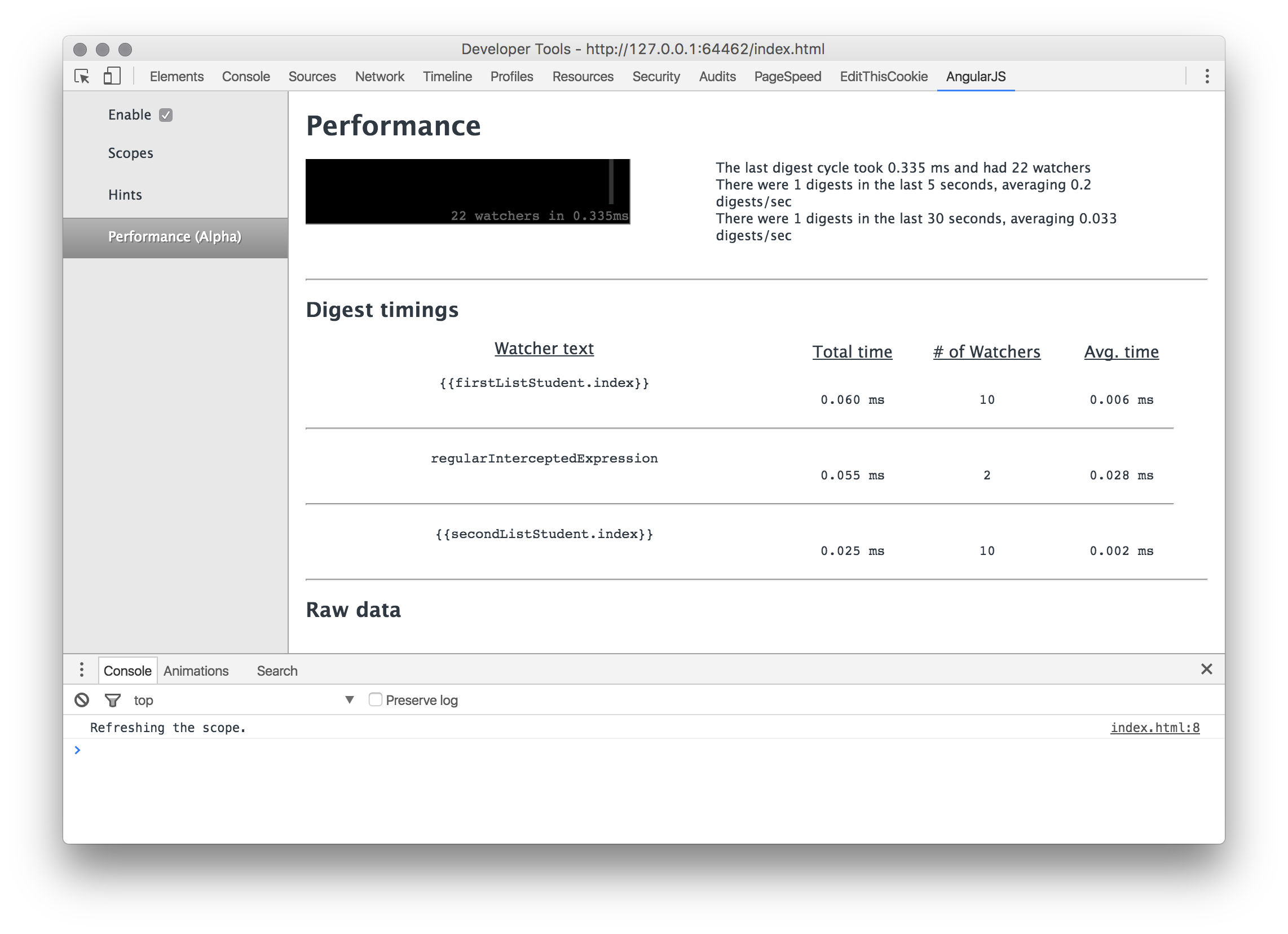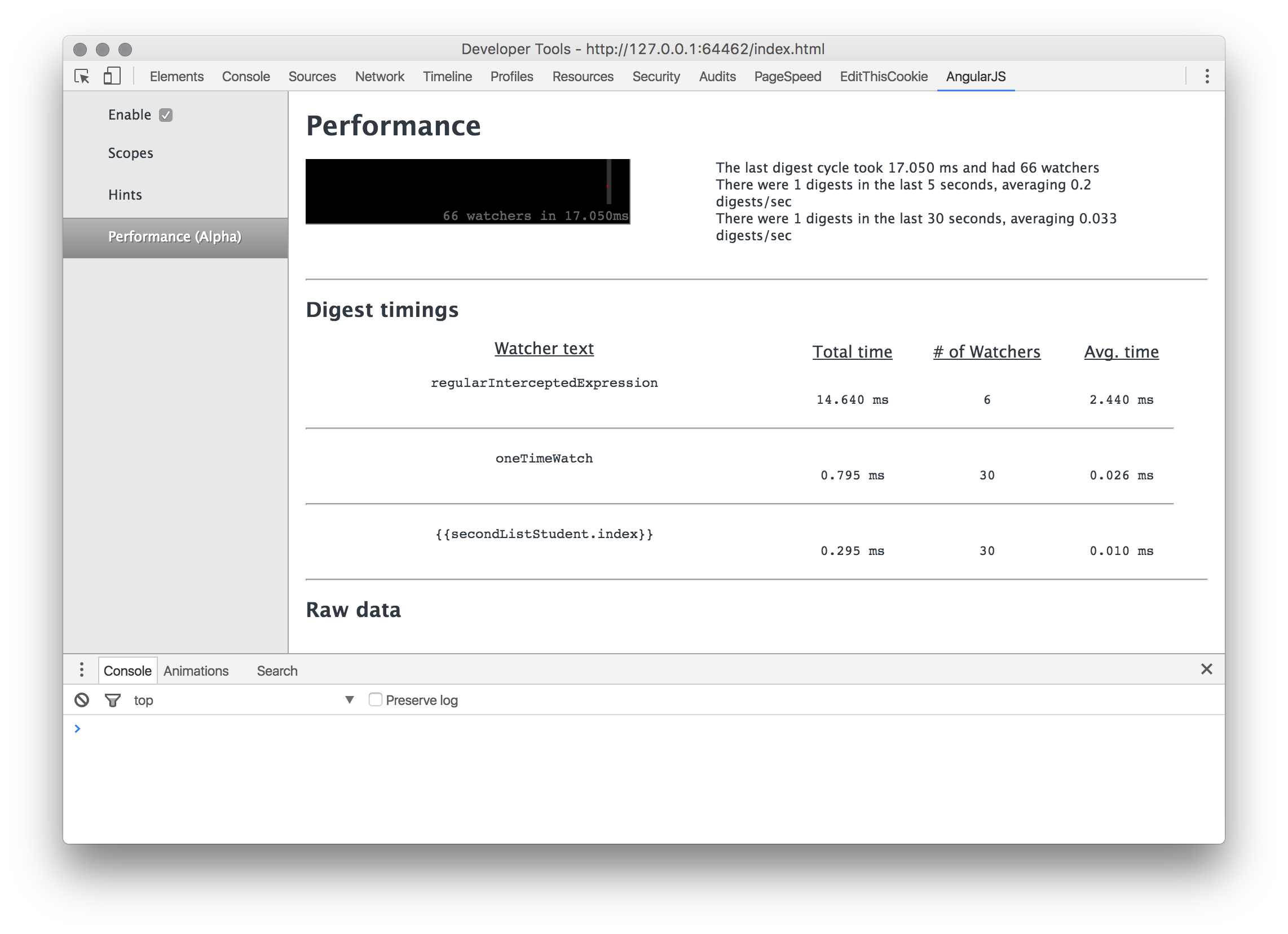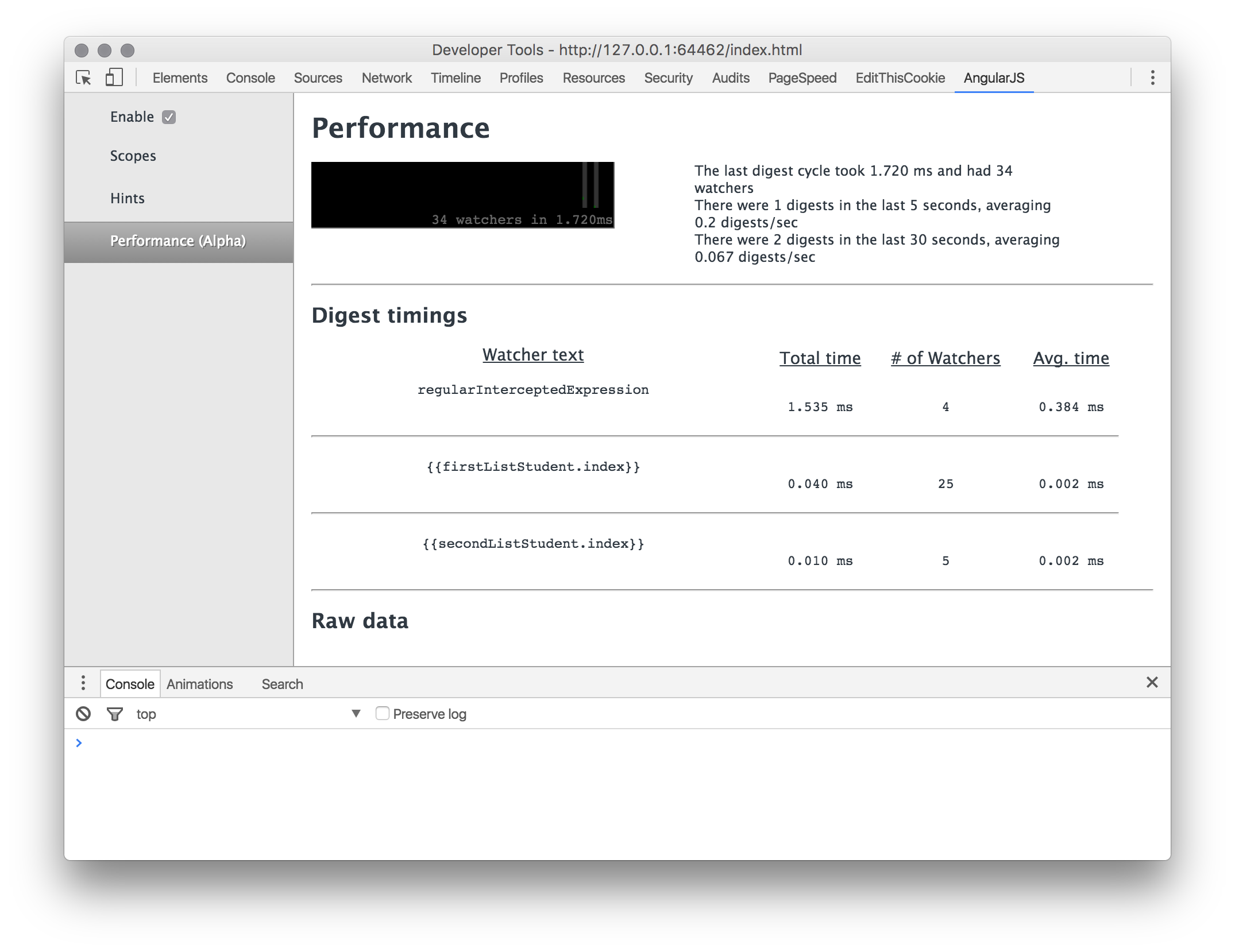Controlling Digests in AngularJS
 AngularJS is a great framework to consider when developing Single Page Applications however, as the displayed datasets grow in size, the application response times deteriorate quickly. In this post I will go through a number of techniques which can be used to tackle these performance problems and I will suggest a new technique to solve this problem. So let’s get started.
AngularJS is a great framework to consider when developing Single Page Applications however, as the displayed datasets grow in size, the application response times deteriorate quickly. In this post I will go through a number of techniques which can be used to tackle these performance problems and I will suggest a new technique to solve this problem. So let’s get started.
Angular Digest
To understand the performance bottlenecks of AngularJS let’s create a simple application which renders a dataset using the ng-repeat directive. Note that we will use {( and )} as start and end interpolation symbols due to some problems on Jekyll.:
<html>
<head>
<script src="https://cdnjs.cloudflare.com/ajax/libs/angular.js/1.5.5/angular.js"></script>
<script src="app.js"></script>
</head>
<body>
<div ng-app="Application" ng-strict-di>
<div ng-controller="ShellController as shellController">
<button ng-click="shellController.forceScopeRefresh()">Force Scope Refresh</button>
</div>
<div ng-controller="OptimisedTestController as optimisedController">
<h1>NGRepeat 1</h1>
<div ng-repeat="firstListStudent in optimisedController.students">
<h3>{(firstListStudent.index)}</h3>
<hr>
</div>
</div>
</div>
</body>
</html>
This dataset uses the students field in the OptimisedTestController controller defined in app.js.
angular.module('Application', [])
.controller("ShellController", function(){
this.forceScopeRefresh = function(){
console.log('Refreshing the scope. ');
};
})
.controller('OptimisedTestController',function(){
this.students = [
{ name: "A", index: 1 },
{ name: "B", index: 2 },
{ name: "C", index: 3 },
{ name: "D", index: 4 },
{ name: "E", index: 5 },
{ name: "F", index: 6 },
{ name: "G", index: 7 },
{ name: "H", index: 8 },
{ name: "I", index: 9 },
{ name: "J", index: 10 }
];
})
Now let’s install Batarang to understand where the performance bottleneck is.

Although the list has 10 elements we can see that 30 watchers are evaulated. Two evaluations per templated element are required to determine whether the value firstListStudent.index (2 * 10 = 20) has changed and another one is needed to render the value (1 * 10 = 10). The number of watchers is proportional to the number of elements. Now let’s add another dataset by adding a TestController controller using the following snippets:
<div ng-controller="TestController as simpleController">
<h1>NGRepeat 2</h1>
<div ng-repeat="secondListStudent in simpleController.students">
<h3>{(secondListStudent.index)}</h3>
<hr>
</div>
</div>
angular.module('Application')
.controller('TestController', function(){
this.students = [
{ name: "A", index: 1 },
{ name: "B", index: 2 },
{ name: "C", index: 3 },
{ name: "D", index: 4 },
{ name: "E", index: 5 },
{ name: "F", index: 6 },
{ name: "G", index: 7 },
{ name: "H", index: 8 },
{ name: "I", index: 9 },
{ name: "J", index: 10 }
];
})
As you can see the number of digests increase proportional with the number of lists. We now have 30 digests for firstListStudent.index in the optimisedController.students and another 30 digest for secondListStudent.index in the simpleController.students

Now let’s click on Force Scope Refresh and see what happens.

As you can see AngularJS executes 10 digests to determine whether any value of firstListStudent.index in the optimisedController.students has changed and another 10 digests to determine whether any value of secondListStudent.index in the simpleController.students has changed. AngularJS is trying to be smart and determine what has changed within the application however this process creates performance bottlenecks as the number of elements in the dataset increases.
Alleviating Problems with Large Datasets
Now that we have understood what the problem is, let’s look at what we can do to alleviate this performance bottleneck:
- Use bind once: bind once (
::) will remove the watched expression from the watchers list after an initial change. Let’s implement this technique on theoptimisedController.studentsdataset by changing the HTML as follows and visualise the number of watchers.
<div ng-controller="OptimisedTestController as optimisedController">
<h1>NGRepeat 1</h1>
<div ng-repeat="firstListStudent in optimisedController.students">
<h3>{(::firstListStudent.index)}</h3>
<hr>
</div>
</div>
When the page is initially loaded we still get 30 watchers per list:

This is expected - AngularJS has to determine the initial change. If we now click on the Force Scope Refresh button we see an improvement:

Now we only have 10 digests of the secondListStudent.index expression. The firstListStudent watchers have been removed from the watchers list due to the bind once expression.
- Limit the visible elements with
limitTo: Since the watches count is directly proportional to the number of items in the list it follows that limiting the number of items to render will result in less watchers being evaluated. To limit the number of elements displayed within angRepeatdirective we can use thelimitTodirective. Let’s limit our previous example to 5 elements per eachngRepeatby changing the HTML snippet as follows:
<div ng-controller="OptimisedTestController as optimisedController">
<h1>NGRepeat 1</h1>
<div ng-repeat="firstListStudent in optimisedController.students | limitTo: 5">
<h3>{(::firstListStudent.index)}</h3>
<hr>
</div>
</div>
<div ng-controller="TestController as simpleController">
<h1>NGRepeat 2</h1>
<div ng-repeat="secondListStudent in simpleController.students | limitTo: 5">
<h3>{(secondListStudent.index)}</h3>
<hr>
</div>
</div>
The initial page load will result in 15 (5 * 3) watchers for firstListStudent and another 15 (5 * 3) watchers for the secondListStudent.

In a way the limitTo directive has been influential in the creation of techniques which optimise the digest lifecycle. Using the limitTo directive we can directly control the timings of the digest cycle - if we load the whole list at once we would have a single digest cycle which takes a long time whereas loading a smaller number of elements in batches (by varying the limitTo parameter) results in a larger number of independent digest cycles taking a relatively smaller time.
LimitTo Variants
Limiting the number of displayed items on the screen is a great way to improve performance however it is not a great experience for the end user. Ideally, when a user reaches the end of the list we provide a way how to load more items from the source dataset. There are various ways how we can achieve the loading of more data. I categorised these techniques into two main categories; Manual Intervention and Automatic.
Manual Intervention
This category encompasses all techniques which require some form of user interaction to signal that more items are desired.
limitTowithngClickcallback: The simplest way how to solve this problem is to give the user directly the option to request more elements. Let’s outline this technique by modifying theOptimisedTestControlleras follows:
angular.module('Application')
.controller('OptimisedTestController',function(){
this.currentLimit = 5;
this.students = [
{ name: "A", index: 1 },
{ name: "B", index: 2 },
...
];
this.loadMore = function(){
if (this.currentLimit < this.students.length)
this.currentLimit = Math.min(this.currentLimit + 5, this.students.length);
};
})
Add a button which calls the new method loadMore to the HTML:
<div ng-controller="OptimisedTestController as optimisedController">
<h1>NGRepeat 1</h1>
<div ng-repeat="firstListStudent in optimisedController.students | limitTo: optimisedController.currentLimit">
<h3>{(firstListStudent.index)}</h3>
<hr>
</div>
<button ng-click="optimisedController.loadMore()">Load More</button>
</div>
Let’s click on the Load More button and visualise the digests

The problem with this solution is that ng-click will start a digest cycle which includes all scopes within the application. As you can see, even though the click originated from within the optimisedController.students list we are still seeing secondStudentList.index watchers present in the testController.students list.
limitTowith localisedclickcallback: AngularJS cannot determine whether a click event will affect the local scope or whether a click event will effect an element outside of the current scope. Due to this lack of knowledge Angular chooses the safe route and usesscope.$applywhich triggers a digest cycle which includes all registered scopes. If we know that a click change is localised within the current scope we can make use of thelocalizedClickdirective defined as follows:
angular.module('Application')
.directive('localizedClick', function(){
function link(scope, element, attrs) {
var format,timeoutId;
element.on('click', function(){
var deferredFn = attrs['localizedClick'];
scope.$eval(deferredFn);
scope.$digest();
});
}
return {
link: link
}
})
Now change the HTML code to the following:
<div ng-controller="OptimisedTestController as optimisedController">
<h1>NGRepeat 1</h1>
<div ng-repeat="firstListStudent in optimisedController.students | limitTo: optimisedController.currentLimit">
<h3></h3>
<hr>
</div>
<button localized-click="optimisedController.loadMore()">Load More</button>
</div>
Notice that by using localizedClick, we localise the digest cycle to just the first ngRepeat scope. In fact we do not see any watchers from the second ngRepeat - secondStudentList.index.

Automatic
The previous two techniques are ones which require manual intervention from users. It would be great if an application could detect when elements should be loaded. There are two techniques in this category which achieve this result:
limitTowith scroll callback: One technique to determine when more elements should be loaded is the technique outlined by Thierry Nicola in his blog. This technique hooks to ascrollevent to determine when the user is ‘close’ (defined by thescrollDistance) to the end of the list. If the user is close to the end new elements are loaded by modifying thelimitTovariable. Thierry has done an amazing job to describe his technique and it would be a great injustice to describe this technique on my blog. I urge you to go to Theirry’s blog entry in which he describes his solution in detail.
Note that the infiniteScroll directive uses scope.$apply(attrs.infiniteScroll) and hence will trigger a digest cycle which will traverse all scopes within your application. If you are going to use this for a number of ngRepeated elements I would consider modifying the directive to use scope.$digest() and localise changes to just the current scope.
limitTowithsetTimeoutcallback: One of the assumptions made by Thierry in his solution is that all elements within the dataset have the same size. Recently, I found myself working on a project where this assumption did not hold true and hence I had to hack a solution to bypass the aforementioned performance issues. The solution is simple, when the application starts we choose an initial limit value, render the elements and schedule a callback to add more elements to the list. Once the scheduled call triggers, thecurrentLimitvariable is incremented and$scope.digest()is called. Note that the solution purposely makes use ofwindow.setTimeoutinstead of$timeout. The$timeoutwould result in a$scope.apply()affecting performance. If you are not sure that your changes will only affect the localngRepeatscope than you could swap thesetTimeoutfor$timeoutor use$scope.$evalAsync().
angular.module('Application')
.controller('OptimisedTestController',['$scope', '$timeout', function($scope, $timeout){
this.initialLimit = 5;
this.batchSize = 5;
this.currentLimit = this.initialLimit;
this.students = [
{ name: "A", index: 1 },
{ name: "B", index: 2 },
{ name: "C", index: 3 },
...
];
var that = this;
this.loadMore = function(){
if (that.currentLimit < that.students.length){
$timeout(function(){
that.currentLimit = Math.min(that.currentLimit + that.batchSize, that.students.length);
$scope.$digest(); // or $scope.$evalAsync() if non-local changes;
that.loadMore();
}, 10, false)
}
};
this.loadMore();
}])
The HTML in our case is as follows:
<div ng-controller="OptimisedTestController as optimisedController">
<h1>NGRepeat 1</h1>
<div ng-repeat="firstListStudent in optimisedController.students | limitTo: optimisedController.currentLimit">
<h3>{(firstListStudent.index)}</h3>
<hr>
</div>
</div>
Conclusion
In this blog entry I have described why AngularJS slows down as the number of elements grow in size and I have gone through a couple of solutions to mitigate this problem. Hope to see you all next time! Stay safe! Keep hacking!